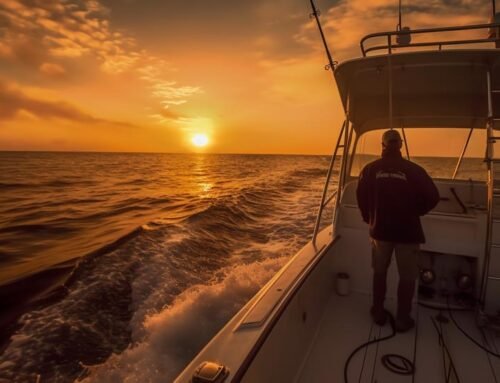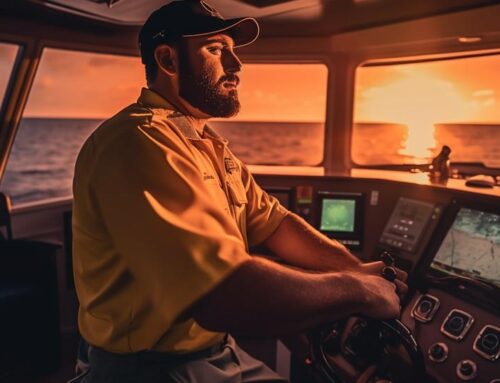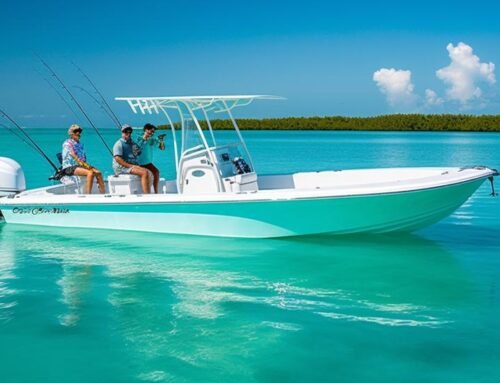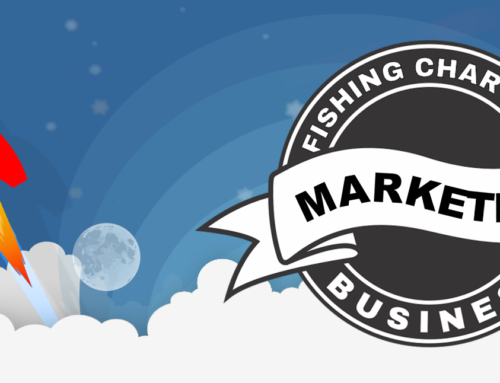Marketing Research Outline for a Fishing Charter Business
Launching a fishing charter business requires in-depth marketing research to navigate competitive waters. Today’s guide covers essential steps, including analyzing market demand, identifying customer demographics, and assessing competitor offerings. It highlights key industry trends such as the growing eco-tourism sector and the role of advanced technology in enhancing customer experience. Learn how to leverage local partnerships, digital marketing strategies, and customer reviews to build your brand. By conducting thorough market research, you’ll be better positioned to attract customers, optimize pricing, and differentiate your charter service from competitors in a crowded marketplace.
Table of Contents
- Market Analysis
- Product Development
- Funding Options
- Go-to-Market Strategy and Customer Acquisition
- Regulatory and Ethical Considerations
- Long-Term Growth Strategies
- Top 5 Frequently Asked Questions
1. Market Analysis
Industry Trends
- Global Growth in Recreational Fishing:
- The recreational fishing industry has seen a steady increase due to a growing interest in outdoor leisure activities. According to the American Sportfishing Association, recreational fishing contributes over $125 billion to the U.S. economy annually.
- Pandemic Influence: The COVID-19 pandemic led to a surge in outdoor activities as people sought safe ways to enjoy leisure time, further boosting the fishing industry.
- Technological Advancements:
- Fishing Equipment: Innovations like advanced fish finders, sonar technology, and GPS mapping have enhanced the fishing experience.
- Booking Platforms: Digitalization has simplified booking processes, with customers preferring online reservations through websites or mobile apps.
- Sustainability and Eco-Tourism:
- Environmental Awareness: There’s a growing emphasis on sustainable fishing practices, with customers seeking charters that prioritize conservation.
- Eco-Friendly Practices: Use of biodegradable materials, adherence to catch limits, and participation in conservation programs are becoming industry standards.
- Demographic Shifts:
- Youth Engagement: Efforts to engage younger demographics through educational programs and youth-friendly trips.
- Diversity: Increased participation from various demographic groups, expanding the potential customer base.
Competitive Landscape
- Local Competition Analysis:
- Service Offerings: Assess competitors’ trip types, pricing, boat capacity, and customer reviews.
- Customer Experience: Evaluate the quality of customer service, the professionalism of crew members, and the overall experience offered.
- Market Saturation:
- High-Demand Locations: Coastal regions and popular tourist destinations may have a saturated market, requiring differentiation strategies.
- Emerging Markets: Consider less-served areas where demand exists but competition is low.
- Differentiation Strategies:
- Specialization: Offer niche services like fly fishing, shark fishing, or eco-tours.
- Value-Added Services: Include amenities such as gourmet meals, luxury accommodations, or educational components.
Real-World Example
- Hooked Up Fishing Charters (Florida):
- Unique Selling Proposition (USP): Specializes in deep-sea fishing for rare species, attracting enthusiasts seeking unique experiences.
- Technology Integration: Utilizes advanced fish-finding equipment and offers a mobile app for easy booking and trip tracking.
- Sustainability Focus: Actively participates in tagging programs for marine research, appealing to eco-conscious customers.
2. Product Development
Service Offerings and Customization
- Trip Varieties:
- Inshore Fishing Trips: Targeting species in shallow waters; suitable for beginners and families.
- Offshore/Deep-Sea Fishing: For experienced anglers seeking big game fish like marlin, tuna, or sailfish.
- Specialty Trips: Night fishing, fly fishing, or spearfishing expeditions.
- Customization Options:
- Private Charters: Exclusive trips tailored to the client’s preferences.
- Group Charters: Shared trips where individuals or small groups can book spots.
- Educational Tours: Guided by marine biologists or experienced anglers, focusing on learning.
Necessary Technology Stack
- Operational Technology:
- Advanced Navigation Systems: GPS chart plotters, radar systems, and autopilot features for safe and efficient navigation.
- Fish-Finding Equipment: Sonar and depth finders to locate fish populations.
- Customer-Facing Technology:
- Website Essentials:
- Responsive Design: Accessible on all devices (desktops, tablets, smartphones).
- Online Booking System: Real-time availability calendars, booking confirmations, and payment processing.
- Content Management System (CMS): For easy updates to content, blog posts, and fishing reports.
- Website Essentials:
- Software and Tools:
- CRM Systems: To manage customer data, track interactions, and personalize communications.
- Email Marketing Tools: Platforms like Mailchimp or Constant Contact for newsletters and promotions.
- Analytics Tools: Google Analytics to track website traffic and customer behavior.
- Mobile Application (Optional):
- Features: Trip scheduling, weather updates, trip reminders, and customer support chat.
- Benefits: Enhances customer engagement and provides a competitive edge.
Key Challenges
- High Initial Investment:
- Cost of Boats and Equipment: Purchasing and outfitting a vessel can be expensive; consider new vs. used boats.
- Maintenance and Repairs: Ongoing costs for upkeep, requiring a maintenance schedule and budget.
- Regulatory Compliance:
- Safety Standards: Meeting all safety regulations requires investment in equipment and training.
- Environmental Regulations: Staying updated on fishing quotas, protected species, and seasonal restrictions.
- Weather Dependence:
- Seasonal Fluctuations: Peak seasons may vary; plan marketing and operations accordingly.
- Cancellation Policies: Develop clear policies for weather-related cancellations to manage customer expectations.
Real-World Example
- Gone Fishin’ Charters (California):
- Technological Edge: Offers virtual reality previews of trips on their website, enhancing customer interest.
- Customer Experience: Provides high-quality gear and personalized services, leading to excellent reviews and repeat business.
3. Funding Options
Investor Strategies
- Business Plan Development:
- Comprehensive Financial Projections: Include startup costs, operational expenses, revenue projections, and break-even analysis.
- Market Potential: Highlight industry growth, target market size, and competitive advantages.
- Pitching to Investors:
- Angel Investors: Seek out individuals interested in maritime businesses or tourism.
- Venture Capital Firms: May be interested if you have a scalable model with technology integration, such as a unique booking platform.
- Investment Terms:
- Equity Sharing: Offering a percentage of ownership in exchange for capital.
- Debt Financing: Loans with agreed repayment terms; may involve collateral.
Bootstrapping
- Personal Savings and Assets:
- Self-Funding: Utilizing personal funds to maintain control and avoid debt.
- Asset Liquidation: Selling non-essential assets to raise capital.
- Incremental Growth:
- Start Small: Begin with a single boat and expand as revenue grows.
- Reinvest Profits: Use initial earnings to fund upgrades and expansion.
- Cost-Saving Measures:
- Leasing Equipment: Reduces upfront costs and allows for easier upgrades.
- Family and Friends: Borrowing funds with flexible terms.
Alternative Funding Sources
- Bank Loans:
- Small Business Loans: Traditional financing through banks or credit unions.
- SBA Loans: Loans guaranteed by the Small Business Administration with favorable terms.
- Crowdfunding:
- Reward-Based Platforms: Offer incentives like free trips or merchandise for contributions.
- Equity Crowdfunding: Investors receive a stake in the company.
- Grants and Subsidies:
- Tourism Grants: Some regions offer grants to businesses that promote tourism.
- Environmental Grants: For companies that incorporate sustainability practices.
Real-World Example
- Fish Tales Charter (Oregon):
- Bootstrapping Approach: Started with personal savings and a single boat; reinvested profits for expansion.
- Community Support: Leveraged local community engagement and received a small business grant from the state tourism board.
4. Go-to-Market Strategy and Customer Acquisition
Market Segmentation
- Tourists:
- Demographics: Families, couples, adventure seekers visiting the area.
- Marketing Channels: Travel websites, local tourism offices, and hotel partnerships.
- Local Residents:
- Fishing Enthusiasts: Regular anglers interested in specialized trips.
- Community Groups: Schools, clubs, or organizations seeking recreational activities.
- Corporate Clients:
- Team Building: Companies looking for unique experiences for employees.
- Client Entertainment: Businesses entertaining clients with exclusive outings.
Marketing Strategies
- Digital Marketing:
- Website SEO:
- Keyword Optimization: Use relevant keywords like “fishing charters [location]” throughout your site.
- Content Creation: Regularly publish blog posts, fishing reports, and articles to improve search rankings.
- Pay-Per-Click Advertising:
- Google Ads: Target specific keywords and demographics.
- Social Media Ads: Utilize Facebook and Instagram ads to reach potential customers.
- Website SEO:
- Social Media Engagement:
- Content Sharing: Post photos and videos of trips, catches, and customer testimonials.
- Interactive Campaigns: Run contests or giveaways to increase engagement.
- Influencer Partnerships: Collaborate with local influencers or fishing enthusiasts for wider reach.
- Email Marketing:
- Newsletter Sign-Ups: Offer incentives for website visitors to subscribe.
- Regular Updates: Send out fishing reports, special offers, and upcoming events.
- Offline Marketing:
- Brochures and Flyers: Distribute at hotels, airports, tourist centers, and local businesses.
- Local Events: Participate in boat shows, fishing expos, and community events.
Customer Acquisition and Retention
- Online Reviews and Testimonials:
- Encourage Feedback: Ask satisfied customers to leave reviews on platforms like TripAdvisor, Yelp, and Google.
- Respond to Reviews: Engage with customer feedback to show attentiveness.
- Referral Programs:
- Incentivize Referrals: Offer discounts or free services for customers who refer others.
- Loyalty Programs:
- Repeat Customer Discounts: Provide special rates or perks for returning clients.
Real-World Example
- Blue Wave Charters (Hawaii):
- Strategic Partnerships: Collaborated with resorts and airlines to offer package deals.
- Strong Online Presence: Invested heavily in SEO and amassed over 1,000 positive online reviews.
- Unique Offerings: Provided underwater photography services, appealing to a niche market.
5. Regulatory and Ethical Considerations
Licensing and Certifications
- Captain’s License:
- OUPV (Six-Pack) License: Allows you to carry up to six passengers; requires documented sea time and passing a Coast Guard exam.
- Master License: For vessels carrying more than six passengers or operating on certain waters.
- Business Registration:
- Legal Structure: Decide on a sole proprietorship, partnership, LLC, or corporation.
- Tax Identification: Obtain an Employer Identification Number (EIN) from the IRS.
- Fishing Permits and Quotas:
- State Permits: Each state has specific regulations; ensure compliance with local fish and wildlife departments.
- Federal Permits: Necessary for certain species or waters, such as migratory fish or operations in federal waters.
Safety and Environmental Regulations
- U.S. Coast Guard Compliance:
- Vessel Inspections: Regular inspections for safety equipment, vessel condition, and operational readiness.
- Crew Training: Mandatory safety training, including CPR and first aid certifications.
- Environmental Protection:
- Protected Species: Be aware of endangered species and avoid prohibited practices.
- Waste Disposal: Adhere to regulations on waste management, including fuel, oil, and garbage.
Insurance Requirements
- Liability Insurance:
- General Liability: Covers accidents or injuries to passengers.
- Hull Insurance: Protects against damage to your vessel.
- Workers’ Compensation:
- Crew Coverage: Required if you have employees, covering injuries or illnesses sustained on the job.
Ethical Practices
- Fair Pricing:
- Transparent Fees: Clearly communicate pricing and any additional costs to customers.
- Cancellation Policies: Have fair and reasonable policies for cancellations and rescheduling.
- Customer Privacy:
- Data Protection: Securely handle personal information collected during booking and communication.
- Cultural and Environmental Sensitivity:
- Local Communities: Respect local customs and contribute positively to the community.
- Education: Inform customers about conservation efforts and responsible fishing practices.
Real-World Example
- EcoFish Charters (Alaska):
- Sustainability Commitment: Operates under strict guidelines to protect local ecosystems.
- Educational Focus: Provides guests with information on local wildlife and conservation.
- Certified Operations: Holds certifications from environmental organizations, enhancing credibility.
6. Long-Term Growth Strategies
Business Scaling
- Fleet Expansion:
- Adding Vessels: Introduce new boats to accommodate more clients and offer varied experiences.
- Diversifying Boat Types: Include different vessels for specific trip types, like luxury yachts or specialized fishing boats.
- Geographic Expansion:
- New Locations: Open operations in other coastal areas or popular fishing destinations.
- Franchising Opportunities: Develop a franchise model to expand under your brand name.
Service Diversification
- Complementary Services:
- Lodging Packages: Partner with hotels or offer accommodations for multi-day trips.
- Transportation Services: Provide pick-up and drop-off services for clients.
- Educational and Training Programs:
- Fishing Schools: Offer courses for different skill levels.
- Certification Programs: Provide certifications for specialized fishing techniques.
Brand Enhancement
- Quality Assurance:
- Consistent Service: Maintain high standards across all operations.
- Customer Feedback Loop: Implement systems to gather and act on customer feedback.
- Marketing Initiatives:
- Rebranding Campaigns: Refresh your brand image periodically to stay current.
- Public Relations: Engage with media outlets for features and stories about your business.
Technological Innovations
- App Development:
- Enhanced Customer Experience: Features like trip tracking, fish identification guides, and virtual tours.
- Loyalty Integration: Include loyalty programs and exclusive offers within the app.
- Data Utilization:
- Customer Analytics: Use data to personalize marketing efforts and improve services.
- Operational Efficiency: Implement software for scheduling, maintenance tracking, and inventory management.
Sustainability and Corporate Social Responsibility (CSR)
- Environmental Initiatives:
- Conservation Projects: Participate in or sponsor local environmental efforts.
- Sustainable Practices: Implement energy-efficient operations and reduce your carbon footprint.
- Community Engagement:
- Local Employment: Hire and train local staff, contributing to the local economy.
- Education Outreach: Host events or programs for local schools and organizations.
Financial Management
- Reinvestment Strategies:
- Profit Allocation: Reinvest a portion of profits into the business for upgrades and expansion.
- Emergency Funds: Maintain reserves for unforeseen circumstances, such as equipment failure or economic downturns.
- Diversifying Income Streams:
- Retail Sales: Open a physical or online store selling gear, apparel, and souvenirs.
- Content Creation: Monetize through fishing shows, YouTube channels, or sponsorships.
Exit Strategy Planning
- Business Valuation:
- Regular Assessments: Keep track of your business’s value for potential sale or investment opportunities.
- Goodwill and Brand Value: Build a strong brand that adds intangible value.
- Succession Planning:
- Training Successors: Prepare key employees to take over leadership roles.
- Selling the Business: Plan for potential sale, merger, or acquisition.
Real-World Example
- Big Catch Charters (Australia):
- Global Recognition: Expanded internationally by offering unique expeditions in multiple countries.
- Technological Leadership: Early adopter of virtual reality experiences for marketing.
- CSR Efforts: Invests in marine conservation and community education, enhancing brand reputation.
Top 5 Frequently Asked Questions
![]()
By diving deeper into each area, this guide provides a thorough roadmap for starting and growing a successful Fishing Charter business. Remember to tailor each aspect to your specific goals, location, and target market. Continuous learning and adaptation are key to navigating the dynamic nature of the industry.
If you need further information or assistance with specific components, feel free to comment below!









